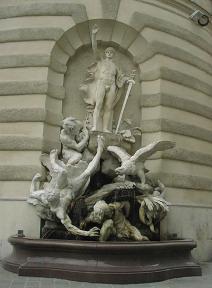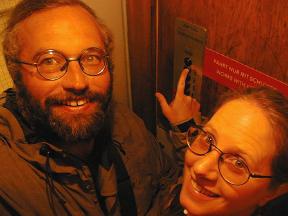
Wien (Vienna)
June 10th - June 13th, 1999

We must admit that for several days into our stay in Wien we felt like we had made the first mistaken visit of our trip. We had hoped for an experience much like the one Salzburg or Innsbruck offers and instead we found something much more akin to a giant shopping mall. The Wien of Mozart is long gone, and in its place you find a very sterile and pompous consumer's paradise. Even the architecture is overbearing, reflecting the heavy hand and tastes of the Hapsburg dynasty which ruled this part of the world for over six hundred years.
However, by the time we left we were glad we came here. While one has to dig hard to find something unique underneath Wein's stifling sameness, it is there. We wouldn't recommend Wien for shopping (too expensive), but a couple of days here are well spent.
Bottled up Wien
The Hapsburgs really built up Wien. Most buildings are six or seven stories tall and pretty imposing structures. Most decorated with sculptures, many of an odd type. Guess it's hard to stand out in Wien today with marble, but they do try. Here are our favorites:
 |
|
|
|
Clockwise from top left: a plague victim from the PestSäule, a gateway sculpture on the Royal Palace, building ornamentation found on a neighborhood walk and the winner: a section of a famous tree that is full of nails. Legend has it that blacksmiths would come and pound a nail into it before leaving Wien. Wieners liked it so much that when the tree died they sealed it in glass in its former location. It's the only tree in the main square.
Peterskirche
Our favorite church in town was one of the oldest. This trip we've seen both restored domes and domes that needed restoration, but Saint Peters was the first dome we saw under restoration. Saint Peters even had matching papal and royal booths to the left and right of the altar -- royalty, of course, on the right. Should look cool when they're done -- no posted completion date.
|
|
|
Hitler's Cafe
After World War II, Germany went through a process of cleansing itself of its Nazi thinking that went so deep as to make even the mention of Adolf Hitler very bad taste. Even to this day, the term "Führer" is seldom spoken and Hitler's name is used purely for shock value. To find any of Adolf Hitler's roots and past, one has to go to Wien where Hitler aspired to be an artist. His favorite hangout was the Cafe Sperl, where we decided to take in coffee and lunch. It's a nice old place, with lovely detailing and billiard tables off of one wing.
|
|
We must admit that the ghosts of stormtroopers' goosestepping didn't echo in our ears. The only things that got brutalized were our wallets.
Ankeruhr

One of Wien's more amusing tourist sights is the Ankeruhr, or Anker Clock. Built in 1914 and installed in the headquarters of the Anker Insurance company, it's a giant linear clock with figurines of Wien fame on each of the hour indicators. At noon of each day, all the figurines march across the face of the clock with organ music from each figurine's era piped out. Well worth the show.
Friendensreich Hundertwasser
We must admit, that for a while we thought it was a mistake to come to Wien. Expensive, staid, sterile -- until we found Hundertwasser. Friendensreich Hundertwasser is the sort of artist that can only come from a reactionary environment like Wein. Hundertwasser decided to rebel against the straight line. As he says, "Die steate Linie ist Göttlos" or "The straight line is godless." He feels the straight line was invented for the machine, not man, and so has been a proponent of architecture that does away with as much linearity as possible.
|
|
As you can see, Hundertwasser uses a most peculiar ruler, and his buildings tend toward an organic feel, with lots of curves and bumps, and lots of trees and plants in them. This floor shot came from the Kunsthaus museum. Hundertwasser has designed a few buildings in Wien, with the most ambitious the Hundertwasserhaus. Below is the model of the house and to the right is the actual front of it. Apparently, the apartments in it are the most coveted addresses in Wien.
|
|
|
|
The bottom two shots are of paintings by Hundertwasser . The one on the left shows how man is integral to his habitat, and shouldn't use houses to insulate him/herself from nature. On the right is a self portrait of Hundertwasser as a boy. Turns out he's half Jewish and lost almost all of his mother's family during World War II -- this painting depicts the effect upon him.
The Vienna Boys Choir

Let's face it; no trip to Wien would be complete without seeing the famed Vienna Boy's Choir. Usually, one needs to reserve tickets months ahead of time, but every Sunday one of the choirs (apparently, there are four Boy's choirs) performs for a nominal fee in the old Hapsburg chapel on the palace grounds. Our cheap seats found us in parlour rooms with video projection screens and rather muffled sound, but if you wait until the mass starts, the usher boys all run off to smoke cigarettes and talk about girls and one is then free to wander around and find better seats. There were a lot of empty chairs about -- apparently 9AM Sunday morning is a bit early for some to make it to mass. We found seats overlooking the congregation and directly beneath the choir's balcony. The German mass was Mozart's mass in C minor and made for a refreshing morning.
Our find in Wien

Wien is generally a very expensive city, but there still remain a few old European-style pensions left, and we managed to find one. Pension Esterhazy at A-1060 Wien, Nelkeng 3, by Mariahilfer Street 67, Tel/Fax: 43-1-587 51 59 offers a clean, quiet room near the city center for about $20/person. If you don't mind a bathroom down the hall, we heartily recommend it. You may find the elevator a bit small (see picture), but at least it has one.